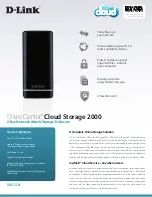
Page 164 SonicWALL TELE3 SP Administrator’s Guide
4. In the Web Management interface for the primary SonicWALL, configure the backup
SonicWALL settings as follows:
•
Serial Number
- Enter the serial number of the backup SonicWALL.
•
LAN IP Address
- The unique LAN IP address used to access and manage the backup
SonicWALL whether it is
Active
or
Idle
.
Note
: This IP address is different from the IP address used to contact the SonicWALL in the
General Network settings.
•
WAN IP Address (Optional)
- This is a unique WAN IP address used to remotely manage
the primary SonicWALL whether it is
Active
or
Idle
.
5. Check the
Preempt mode
checkbox if you want the primary to SonicWALL to takeover
from the backup SonicWALL whenever the primary becomes available (for example, after
recovering from a failure and restarting). If this option is not used, the backup SonicWALL
remains the active SonicWALL.
Note
: The primary and backup SonicWALLs use a “heartbeat” signal to communicate with one
another. This heartbeat is sent between the SonicWALLs over the network segment connected
to the LAN ports of the two SonicWALLs. The interruption of this heartbeat signal triggers the
backup SonicWALL to take over operation from the active unit of the
High Availability
pair.
The time required for the backup SonicWALL to take over from the active unit depends on the
Heartbeat Interval
and the
Failover Trigger
Level.
6. Enter the
Heartbeat Interval
time in seconds. Use a value between 3 seconds and 255
seconds. This interval is the amount of time in seconds that elapses between heartbeats
passed between the two SonicWALLs in the
High Availability
pair.
7. Enter the
Failover Trigger Level
in terms of the number of missed heartbeats. Use a
value between 2 and 99 missed heartbeats. When the backup unit detects this number of
consecutive missed heartbeats, the backup SonicWALL takes over operation from the
active unit.
Example
: Assume that the
Heartbeat Interval
and the
Failover Trigger Level
are 5
seconds and 2 missed heartbeats respectively. Based on these values, the backup SonicWALL
takes over from the active unit after 10 seconds in the event of a failure in the active unit.
8. Enter the
Active SonicWALL Detection Time
in seconds using a value between 0 and
300. The default value of 0 is correct in most cases.When any SonicWALL (primary or
backup) becomes active after bootup, it looks for an active SonicWALL configured for High
Availability on the network. If another SonicWALL is active, the SonicWALL that is booting
up transitions to the
Idle
mode. In some cases, there may be a delay in locating another
SonicWALL due to network delays or problems with hubs or switches.You can configure
either the primary or backup SonicWALL to allow an increment of time (in seconds) to look
for another SonicWALL configured for
High Availability
on the network. You may enter
a value between 0 and 300 seconds, but the default value of 0 seconds is sufficient in most
cases.
















































